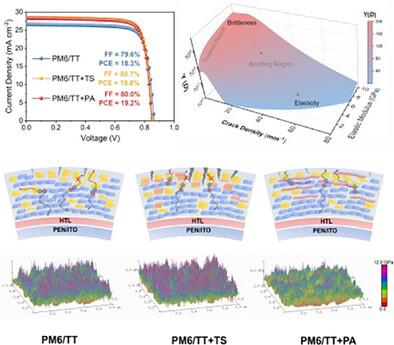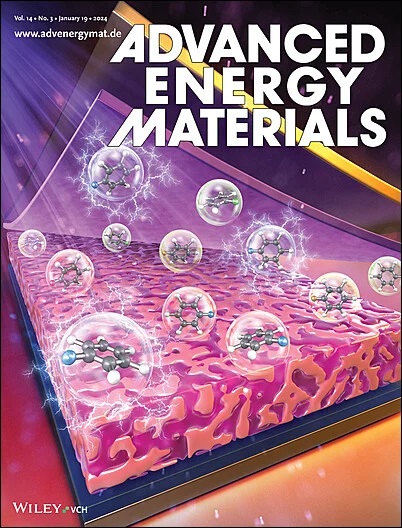Boosting the Efficiency and Mechanical Stability of Organic Solar Cells Through a Polymer Acceptor by Reducing the Elastic Modulus
IF 24.4
1区 材料科学
Q1 CHEMISTRY, PHYSICAL
引用次数: 0
Abstract
Organic solar cells (OSCs) are regarded as one of the most promising flexible power sources due to their lightweight and flexible properties, with the improvement of photovoltaic and mechanical performance. To improve the current density and power conversion efficiency (PCE), mPh4F-TS (TS) and PYSe2F-T (PA) are introduced into the binary host, PM6/mPh4F-TT (PM6/TT) as third components. It is demonstrated that the corresponding ternary devices, in both rigid and flexible devices, achieved superior efficiencies (19.6%/17.7% for PM6/TT+TS, and 19.2%/17.4% for PM6/TT+PA) outperform the binary counterparts (18.3%/16.4%). However, distinct differences in mechanical performance are observed between the polymer acceptor (PA) and small-molecular acceptor (TS). The PM6/TT+PA significantly improved the mechanical stability of flexible devices with a lower elastic modulus of 3.6 GPa, while the PM6/TT+TS resulted in the opposite effect with a higher elastic modulus of 5.5 GPa. Through in-depth investigation, a clear correlation between the elastic modulus, crack density, and mechanical stability of the active layer blends is successfully established, revealing the key role of reducing the elastic modulus in enhancing the mechanical stability of flexible OSCs. This study provides important guidance for the development of flexible photovoltaic devices with both high efficiency and mechanical robustness.

求助全文
约1分钟内获得全文
求助全文
来源期刊

Advanced Energy Materials
CHEMISTRY, PHYSICAL-ENERGY & FUELS
CiteScore
41.90
自引率
4.00%
发文量
889
审稿时长
1.4 months
期刊介绍:
Established in 2011, Advanced Energy Materials is an international, interdisciplinary, English-language journal that focuses on materials used in energy harvesting, conversion, and storage. It is regarded as a top-quality journal alongside Advanced Materials, Advanced Functional Materials, and Small.
With a 2022 Impact Factor of 27.8, Advanced Energy Materials is considered a prime source for the best energy-related research. The journal covers a wide range of topics in energy-related research, including organic and inorganic photovoltaics, batteries and supercapacitors, fuel cells, hydrogen generation and storage, thermoelectrics, water splitting and photocatalysis, solar fuels and thermosolar power, magnetocalorics, and piezoelectronics.
The readership of Advanced Energy Materials includes materials scientists, chemists, physicists, and engineers in both academia and industry. The journal is indexed in various databases and collections, such as Advanced Technologies & Aerospace Database, FIZ Karlsruhe, INSPEC (IET), Science Citation Index Expanded, Technology Collection, and Web of Science, among others.
 求助内容:
求助内容: 应助结果提醒方式:
应助结果提醒方式:


